Key takeaways:
- Clay bars effectively remove deep-seated contaminants, enhancing both the appearance and longevity of a vehicle’s paint.
- Proper lubrication and technique are crucial for using a clay bar effectively, preventing damage to the paint surface.
- Investing in quality clay bars can significantly improve detailing results and save time and effort in maintenance.
- Common mistakes include neglecting lubrication, using contaminated bars, and skipping post-treatment maintenance like waxing.
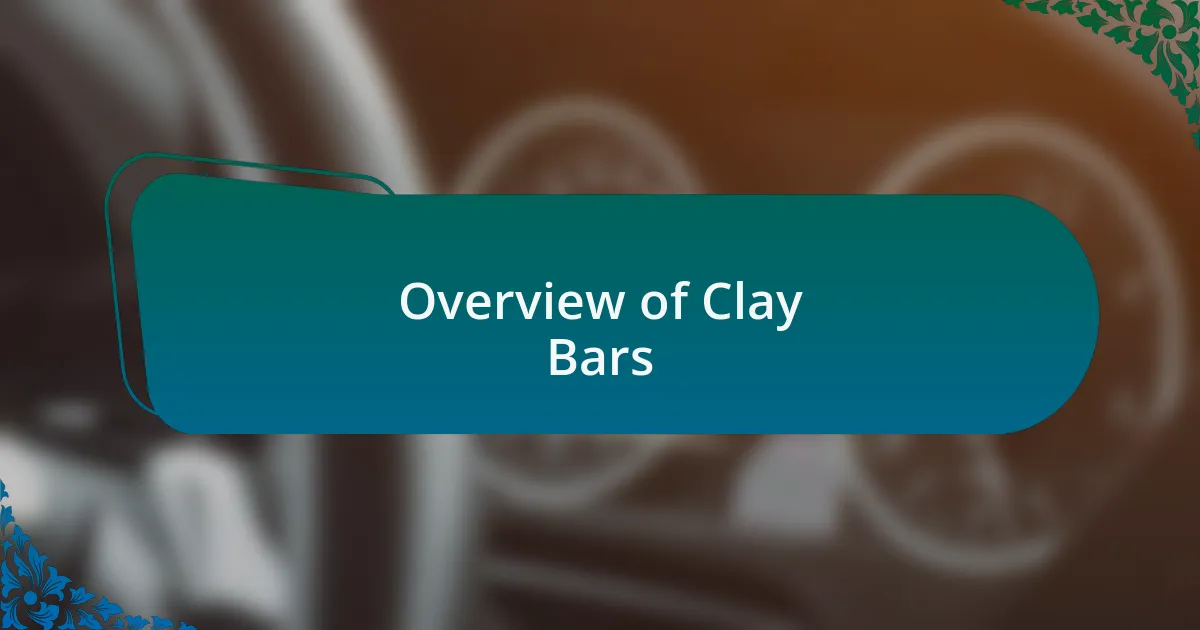
Overview of Clay Bars
Clay bars are a remarkable detailing tool designed to remove contaminants from a vehicle’s paintwork. Unlike traditional washing methods, clay bars can reach deep into the surface, lifting away embedded dirt, tree sap, and pollution that washing alone may not address. I remember my first experience using one; the instant smoothness of the paint afterward was nothing short of magical.
When you slide a clay bar over your car’s surface, you’re essentially performing a deep clean that enhances not just the look, but also the feel of your vehicle. Have you ever noticed a rough texture on your freshly washed car? That’s where a clay bar can work wonders. I still recall the satisfying sound it made as it glided over the paint, transforming that roughness into an effortless shine.
The process may seem daunting, but using a clay bar is straightforward and can significantly elevate your car’s appearance. I found it surprisingly therapeutic—there’s something about meticulously working on your vehicle that connects you to it. After all, don’t we all deserve to enjoy our cars at their very best?
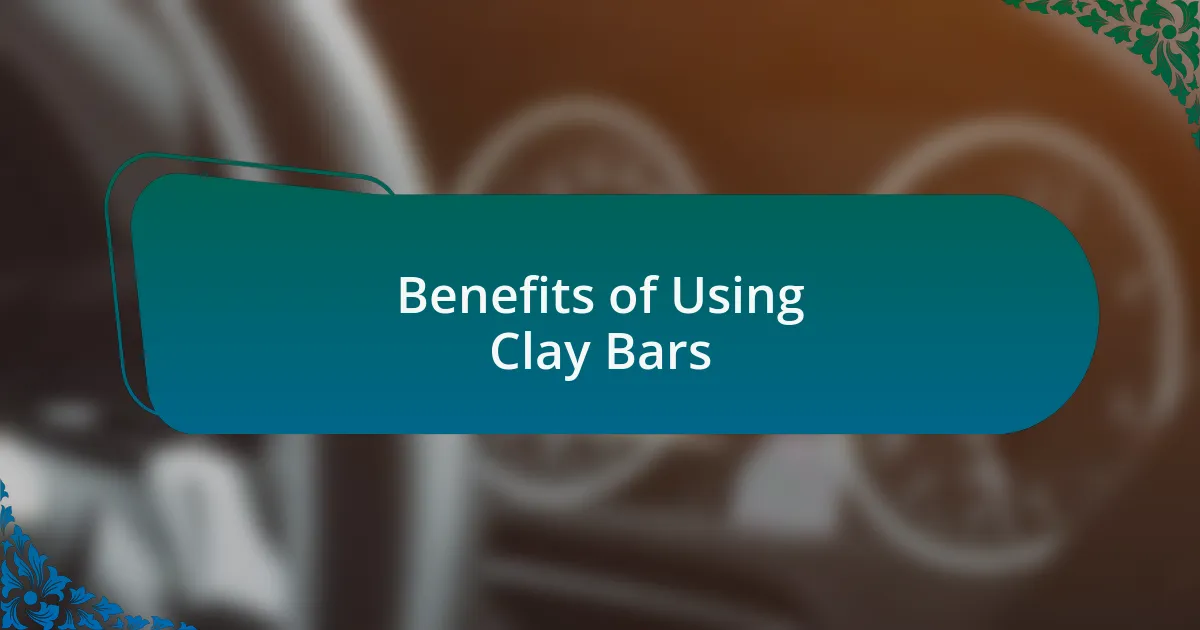
Benefits of Using Clay Bars
Using a clay bar truly elevates the overall appearance of a vehicle. After my first clay bar experience, I was amazed at how the paint looked like it just rolled off the showroom floor. It not only restored the gloss but also made the colors pop in a way that had me admiring my car like it was brand new again.
One of the most significant benefits I found was how clay bars can extend the life of your car’s paint. By removing contaminants, you’re decreasing the chances of rust and corrosion settling in over time. I can’t help but think back to a friend who neglected this step; his car’s finish worsened faster than he anticipated. It’s a stark reminder that keeping the paint surface clean will save you headaches and costs down the road.
What surprised me the most was the added ease it brought to the waxing process. When I applied wax after claying, it spread like butter, creating an even layer across the surface. It made me wonder—why wouldn’t everyone incorporate clay bars into their detailing routine? The benefits are just too significant to overlook for anyone serious about maintaining their vehicle’s appearance.

How to Use Clay Bars
To use a clay bar effectively, start by washing your vehicle thoroughly. I remember the first time I clayed my car; I was eager to jump in but realized that a clean surface is crucial. Contaminants can impede the clay’s performance, so patience is key here. After washing, a quick rinse and drying will ensure you’re working on a smooth canvas.
Next, lubricate the area you’ll be working on with a dedicated clay lubricant or a mixture of water and a few drops of car wash soap. When I first applied the lubricant, I was amazed at how slick the surface felt. It’s almost like a dance—glide the clay bar over the paint with light pressure and a back-and-forth motion. If you feel any resistance, don’t hesitate to add more lubricant; it’s all about keeping the interaction as smooth as possible.
Check the clay bar often, folding and kneading it as needed. I’ve had moments where I discovered stubborn spots that made me think, “Is this really going to work?” But by inspecting the bar and reshaping it to expose fresh surface areas, I was able to tackle those tough challenges. Just remember, the key is to stay gentle yet consistent, letting the clay do the heavy lifting while you guide it along the surface.
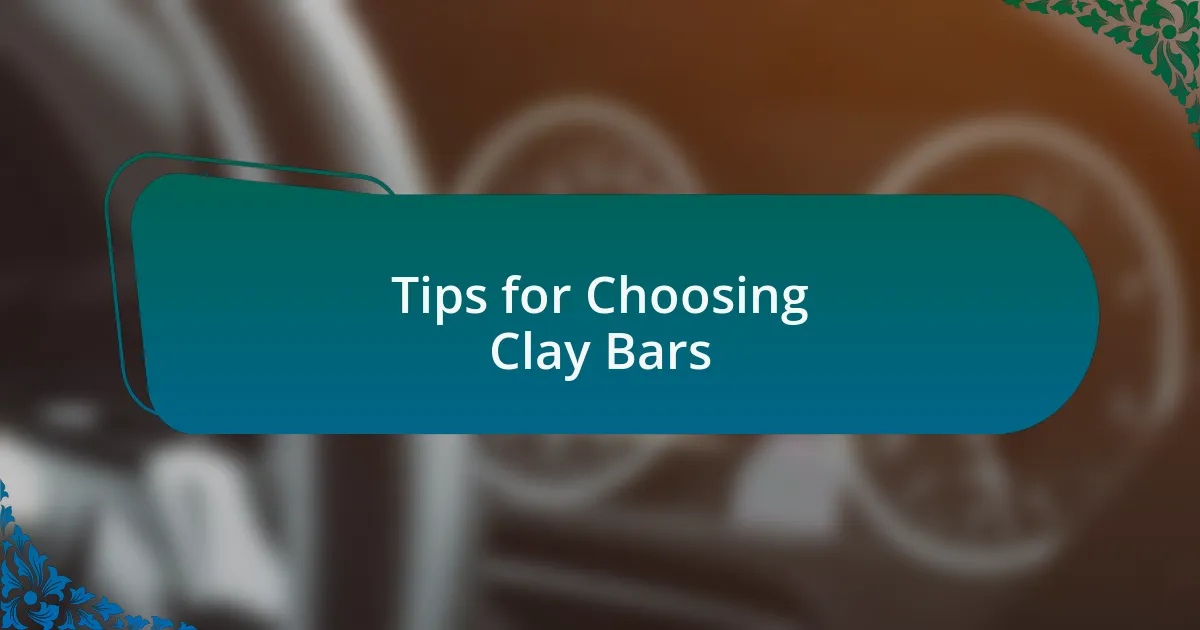
Tips for Choosing Clay Bars
When selecting a clay bar, consider the type of contaminants you frequently encounter. For instance, I often face industrial fallout in urban areas, so I tend to reach for a medium to heavy-grade clay bar. Have you ever tried a clay bar only to find it ineffective? A softer bar might be better for light decontamination if your vehicle is relatively new and well-maintained.
Pay attention to the brand and user reviews as well. There was a time when I opted for a lesser-known brand based on price alone, and I regretted it. Quality matters; a reliable clay bar will not only perform better but also last longer, saving you time and money in the long run. Remember, the right choice can transform your detailing experience from tedious to exhilarating.
Finally, don’t shy away from trying different options. Experimenting with various types was an eye-opening experience for me. I found that using a finer clay bar on my freshly painted vehicle left it feeling as smooth as silk, while a more aggressive one helped deeply clean my older car. What are you willing to try to elevate your car care routine? Sometimes, stepping out of your comfort zone can lead to impressive results.

My Experience with Clay Bars
When I first used a clay bar, I was pleasantly surprised by the immediate difference in my car’s surface. The first swipe felt like gliding over glass, and I couldn’t believe how much grime it pulled off. Have you ever had that moment when you discover a product that changes everything? For me, that was the clay bar.
I remember tackling my SUV after a long weekend of camping, and it looked like a mess. I was skeptical, thinking nothing could revive that paint. But as I worked the clay bar over it, I felt a sense of accomplishment build up inside me—it was not just cleaning; it was restoring pride in my ride. There’s something so satisfying about seeing years of neglect wash away, leaving behind that fresh, clean feel.
Occasionally, I still come across that resistance when I try a new technique, like using a clay bar. Once, I accidentally pressed too hard and left some marks—definitely a learning moment. I realized that it’s all about finding the right pressure and technique. Have you ever felt hesitant to push through a new challenge? Sometimes, those small mishaps lead to the best breakthroughs in our skills.
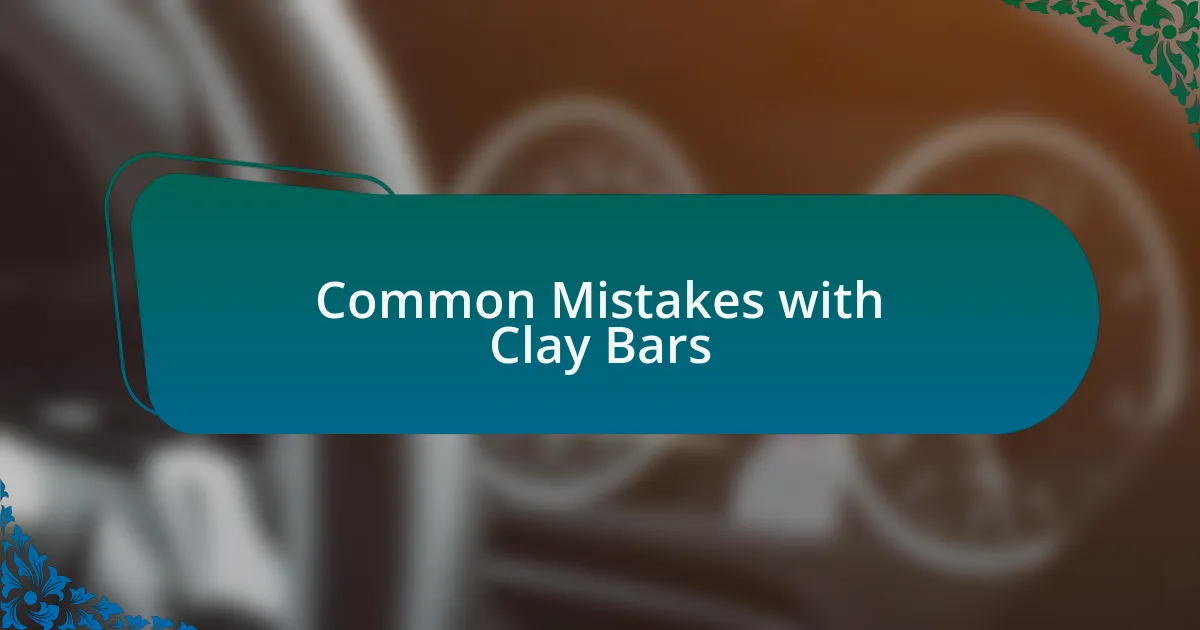
Common Mistakes with Clay Bars
Using a clay bar sounds straightforward, but I’ve noticed many people make critical mistakes that can lead to disappointing results. One common error is neglecting to lubricate the surface properly. I remember the first time I thought, “Do I really need that spray?” After trying to use a clay bar without sufficient lubrication, I found it snagged and left behind streaks on the paint, which was frustrating and time-consuming to fix.
Another mistake I often see is treating clay bars as if they last forever. I’ve made this blunder myself by thinking I could save time by using the same benighted piece for too long. It’s crucial to remember that clay bars can get dirty, and using a contaminated bar can actually grind particles into the paint instead of removing them. Have you ever realized too late that what you were saving was doing more harm than good? Trust me, investing in a fresh clay bar is always worth it for the sake of your car’s finish.
Lastly, there’s the tendency to skip maintenance afterward. After my first successful clay bar session, I thought the hard work was done. However, I quickly learned that neglecting to apply a fresh layer of wax afterward meant my car didn’t stay protected. Have you noticed how quickly dirt and grime can accumulate again? Keeping up with this step is essential for long-lasting results and can make your efforts more rewarding.
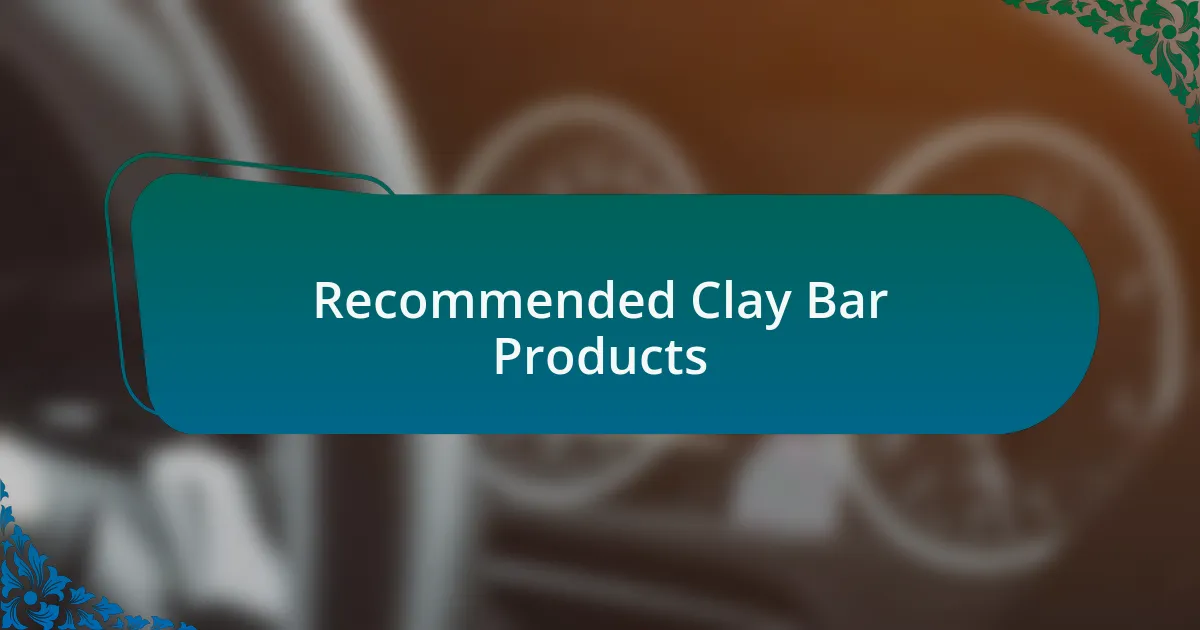
Recommended Clay Bar Products
When it comes to choosing a clay bar, I highly recommend the Meguiar’s Smooth Surface Clay Kit. My first experience with this product was eye-opening; it glided across my car’s surface with such ease. I remember feeling a sense of satisfaction as I watched it lift away embedded contaminants effortlessly. Have you ever felt that rush when the paint starts to shine again?
Another excellent option I’ve encountered is the Griot’s Garage Paint Cleaning Clay. This clay bar is particularly forgiving for beginners. I’ve often found that its slightly softer texture reduces the chance of marring, which is a relief for anyone a bit anxious about damaging their car’s finish. Have you ever worried about making that first scratch? With this product, I felt more confident tackling my car’s detailing needs.
For a professional-grade clay bar, I’d point you to the Chemical Guys Medium Clay Bar. I have personally used it for tough spots, and it made a noticeable difference. I still remember the day I freed my car from years of neglected grime—talk about satisfying! Do you enjoy transforming your car from dull to dazzling? If so, investing in a product like this can truly elevate your detailing game.